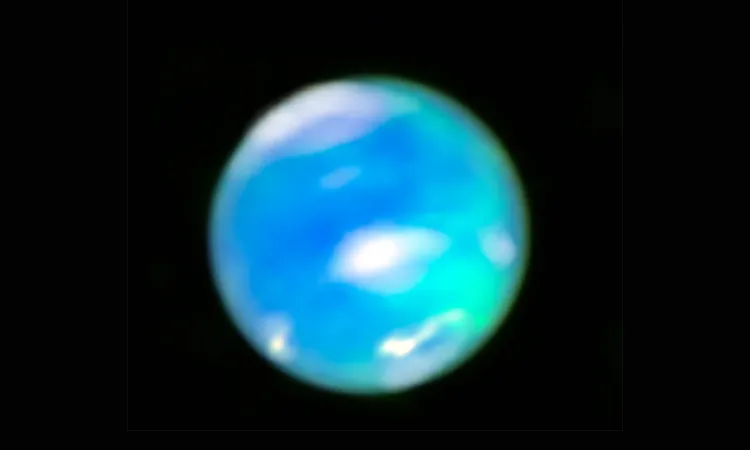
Neptune’s Stunning Auroras Captured for the First Time by JWST
2025-03-30
Author: Lok
In a groundbreaking revelation for astronomers, the James Webb Space Telescope (JWST) has successfully captured stunning images of auroras on Neptune, confirming their existence for the very first time. This marks a significant milestone in planetary science, as Neptune's auroras were previously only a theoretical concept.
According to the data collected, energetic particles originating from the Sun have been identified striking Neptune's ionosphere, leading to the release of distinct glowing emissions. These interactions create the auroras that are now vividly displayed in Webb's near-infrared images.
While the auroras of other gas giants like Jupiter, Saturn, and Uranus have been documented, Neptune has remained an enigma. Previous evidence from NASA's Voyager 2 during its 1989 flyby suggested the presence of auroras, but it was not until the advent of JWST that astronomers could definitively prove their existence.
Lead researcher Henrik Melin from Northumbria University expressed his astonishment, stating, “It was absolutely stunning to see not just the auroras, but the unexpected detail and clarity in the images.” The JWST captured these remarkable visuals in June 2023 utilizing its Near-Infrared Spectrograph, also providing critical spectral data that revealed insights into Neptune’s atmospheric temperature and chemical composition.
Notably, astronomers identified a strong emission line from H3+, a molecule formed during auroras, appearing as cyan-colored patches in the imagery. H3+ serves as a reliable marker for auroral activity in gas giants and has been effectively utilized to monitor such phenomena on Jupiter, Saturn, and Uranus. However, Neptune’s auroras had evaded detection until now.
Heidi Hammel, Webb's interdisciplinary scientist, emphasizes the significance of this discovery, noting, “H3+ has been a clear indicator of auroral activity on all gas giants, and only with an advanced observatory like JWST have we finally confirmed its presence on Neptune.” This finding supports longstanding suspicions within the scientific community that the evidence of auroras was simply hidden beneath the complexities of Neptune's atmosphere.
Interestingly, unlike Earth's auroras which predominantly occur near the poles, Neptune’s auroras appear in mid-latitudes. This anomaly can be attributed to Neptune’s magnetic field, which, as discovered by Voyager 2, is tilted at a significant angle of 47 degrees relative to the planet's rotational axis, shifting the expected locations of the auroras.
Furthermore, JWST's analysis revealed that Neptune's upper atmosphere has markedly cooled since the last observations made in 1989, with temperatures plummeting by several hundreds of degrees. This chilling trend could explain why Neptune's auroras had been undetectable for so long; as temperatures drop, the brightness of auroras diminishes, rendering them less visible.
These findings pave the way for an exciting new era of research focused on ice giants. Scientists are now planning to monitor Neptune throughout a full solar cycle, which spans approximately 11 years. This will permit a deeper understanding of the planet’s changes in relation to solar activity, magnetic fields, and atmospheric dynamics.
Leigh Fletcher from Leicester University, who co-authored the study, asserted that future missions to study Uranus and Neptune will benefit immensely from instruments capable of observing infrared wavelengths. JWST has opened a window into the previously hidden realm of auroras among the giant planets, igniting interest in exploring these enigmatic worlds.
The research findings have been published in the prestigious journal, Nature Astronomy, paving the way for further exploration of our solar system’s most distant frontiers.


 Brasil (PT)
Brasil (PT)
 Canada (EN)
Canada (EN)
 Chile (ES)
Chile (ES)
 Česko (CS)
Česko (CS)
 대한민국 (KO)
대한민국 (KO)
 España (ES)
España (ES)
 France (FR)
France (FR)
 Hong Kong (EN)
Hong Kong (EN)
 Italia (IT)
Italia (IT)
 日本 (JA)
日本 (JA)
 Magyarország (HU)
Magyarország (HU)
 Norge (NO)
Norge (NO)
 Polska (PL)
Polska (PL)
 Schweiz (DE)
Schweiz (DE)
 Singapore (EN)
Singapore (EN)
 Sverige (SV)
Sverige (SV)
 Suomi (FI)
Suomi (FI)
 Türkiye (TR)
Türkiye (TR)
 الإمارات العربية المتحدة (AR)
الإمارات العربية المتحدة (AR)